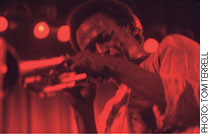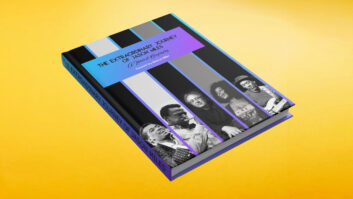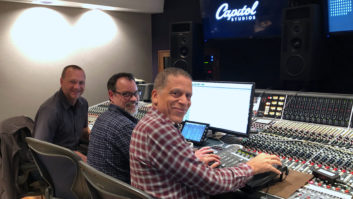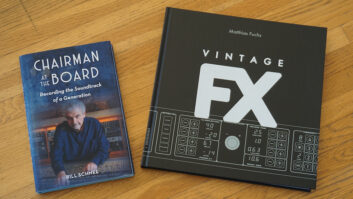
In December 1969, Miles Davis boasted, “I could put togetherthe greatest rock ‘n’ roll band you ever heard.” It must havesounded rather presumptuous, because the jazz trumpeter had only begunto flirt with electric instruments and rock influences at the very endof 1967. And if there were two things beyond dispute in the confusedand turbulent ’60s, it was that jazzers couldn’t rock and rockerscouldn’t play jazz. Moreover, Bitches Brew, Davis’ seminal blendof rock and jazz, and the first entirely successful attempt at fusingthe two musical directions, was recorded only a few months earlier andhad not been released yet.
Davis attempted to prove his rock ‘n’ roll point during a series ofintense sessions in the first half of 1970. Some of the results werereleased as the soundtrack to a documentary movie by director WilliamCayton about Jack Johnson, who had become the first African-Americanheavyweight boxing champion in 1908. The soundtrack, titled ATribute to Jack Johnson, fell largely on deaf ears when it wasreleased in 1971, despite featuring jazz luminaries such as JohnMcLaughlin, Herbie Hancock and Billy Cobham, and arguably the strongesttrumpet playing of Davis’ entire career. The album, which is laced withchurning funk and rock rhythms that had never been blended quite thisway before, never attained the iconic status of Bitches Brew orDavis’ ambient jazz-rock epic of the same era, In a SilentWay.
Yet over time, the reputation of Davis’ A Tribute to JackJohnson has grown considerably, and its standing was furtherenhanced late last year when Columbia/Legacy released seven hours ofmusic from those early 1970 sessions on a 6-CD boxed set called TheComplete Jack Johnson Sessions. The set is the latest in a line ofmuch-lauded and Grammy-laden Davis boxes, which includes such importantmaster works as The Complete Miles Davis With John Coltrane,1955-1961 (six CDs); The Complete Live at the Plugged Nickel(eight CDs), Miles Davis & Gil Evans (six CDs); TheComplete Columbia Studio Recordings of the Miles Davis Quintet,1965-1968 (six CDs); The Complete Bitches Brew Sessions,1969-1970 (four CDs); and The Complete In a Silent Sessions,1968-1969 (three CDs).
Conceptually, these boxed sets are the brainchildren of reissueproducers Bob Belden and Michael Cuscuna, while the main technical manbehind them is mastering engineer Mark Wilder of Sony Music Studios inNew York. Wilder has worked for Sony since the late 1980s, switchedexclusively to mastering in the mid-1990s, but has been “happy tocome out of engineering retirement” to work on the Davis boxedsets.
Wilder reveals that for the boxed sets that cover music from the1950s and 1960s, most of the 2-track mixdown masters had deterioratedto such a degree that the decision was made to remix all material fromthe original multitrack masters. “For the Miles and Gil boxedset, I was dealing with a half-inch 3-track format,” Wilderexplains, “and the quintet material was recorded on 4-track. TheIn a Silent Way, Bitches Brew and most of the JackJohnson material was on 1-inch 8-track, with some of the finalsessions from 1970 on 1-inch 16-track.”

Famously, the original producer of the music, Teo Macero, appliedsome of the most intense post-production ever witnessed at the time toDavis’ music. Some of the material on In a Silent Way was loopedin a manner reminiscent of dance music today, while several of thetracks on Bitches Brew contain dozens of tape edits to constructnew musical structures. Macero was at his most outrageous on the threemain previously released tracks that appear on the Jack Johnsonboxed set: “Right Off” and “Yesternow” (bothwere on A Tribute to Jack Johnson), and “Go AheadJohn” (which appeared in 1972 on the Big Fun collection ofouttakes).
On the original versions of these three tracks, there’s no attemptmade to hide the edits: Wild, unexpected tape splices are apparent toeven the most casual listener. Macero also threw in orchestra, arcobass segments and even a bit of In a Silent Way, and combinedthem with an unrelated solo by Davis. On top, “Go AheadJohn” was spiced up with some technical devices invented byColumbia’s research department. One was the “electronicswitcher,” which made it possible to instantly move a channel tospecific positions in the stereo spectrum. The other was the“instant playback,” which allowed entire passages to beplayed back at 30- to 40-second intervals, again in a manner nowcommonplace in electronic music.
While Belden, Cuscuna and Wilder had chosen on earlier boxed sets toretrace Macero’s steps and replicate all of the edits and effects heapplied, the approach on the new Jack Johnson boxed set isnotably different. “Right Off” and “Yesternow”are included exactly as they were released in 1971 — remasteredfrom the original 2-track masters; the rest of the boxed set includesmany different versions of the original takes from which Macero culledhis edits, plus many outtakes that he never used.
Cuscuna explains some of the rationale: “On BitchesBrew, the edits aimed to blend together performances of a certaintrack that were recorded in sections. But in the Jack Johnsonera, there were only jams and the focus was on the playing. Very littlefrom this era had been released, and the three main tracks were heavilyedited and manipulated. So the idea of the boxed set was to capture theperformances as the musicians played them at the time.”
“The aim was for this to be more of a documentary of thesessions,” clarifies Wilder. “We weren’t trying to equalTeo. This was a great period for Miles and we wanted listeners tounderstand what happened during this period, and so we eliminated allthe technical elements that Teo added. We really wanted to bring outthe communication between the musicians. Also, there were ingredientsthat appeared on the original versions of ‘Right Off’ and‘Yesternow’ that we couldn’t trace, and Teo’s work is sogreat it would have been a chore to try to re-create it, even if we hadbeen able to.
“Also, the original Jack Johnson tapes were all ingreat shape. I mastered ‘Right Off’ and‘Yesternow’ directly from the 2-track mixes. It’s actuallythe third time I mastered these tapes. I first did them in the late1980s for the Contemporary Jazz Masters Series, then the newerCD version that’s been out for a while and then again for the boxedset. They’re among my shortest mastering sessions, because the music isfantastically recorded and mixed. ‘Right Off’ and‘Yesternow’ take the same EQ, and the whole thing is donebefore lunch!”
The sonic quality of the digital masters Wilder made of “RightNow” and “Yesternow” increases noticeably with eachnew version. According to the engineer, this is due to the improvementsin digital technology during the years. He elaborated on some of thetechnical details involved in the making of The Complete JackJohnson Sessions, beginning with his approach to mixing theoriginal sessions.
“All mixes were done in Studio C at Sony Studios, wherethere’s an SSL 9000 J Series desk and a Studer with a custom 8-tracktape recorder. The original music was recorded extremely well by StanTonkel, who knew how to hit the tape well and how to record electricinstruments — in smaller studios, and with more isolation thanwas customary for most jazz records at the time. The tracks were cleanand loud and punchy. Somehow, he also knew who was going to play when,because it was rare that I had to deal with two instruments playing onthe same track at the same time and worry about how to createseparation. Drums were in mono — it wasn’t until the 16-trackperiod that you began seeing drums on more than one track atColumbia.
“We did listen to Teo’s and Stan’s mixes, but mainly what Idid was set up an image placement for each session, and I’d just leavethe instruments there,” Wilder continues. “So JohnMcLaughlin would be on the left, Miles in the middle, the drumsslightly right of center and the bass left of center, and they wouldremain there. So there was a foundation of listening where you feltlike you were experiencing the session. Reverbs and delays I added bytaste, mainly using EMT plates and a Lexicon 960L for the surround. Ialso used a full range of Pultec EQs and AP I550 EQs and compression asneeded, such as LA-2A, dbx or UREI 1176.
“From the SSL, the signal went straight into the Sonoma via aset of Meitner DSD converters. The Sonoma is Sony’s proprietary,custom-built digital workstation for SACD work. SACD is based on DSDtechnology, which works by 1-bit sampling at a 2.83MHz sampling rate. Ihave always found DSD sounds better than PCM: Because DSD samples use amuch larger slice of music, it allows for the music to retain itsanalog curve rather than being broken up in loads of tiny individualcomponents, as with PCM.
“Both the stereo and the 5.1 mixes ended up in the Sonomasystem, and I’d then use an SBM-Direct box to take the DSD signal downto 44.1k/24-bit PCM level. I then used a Daniel Weiss Pow-Rnoise-shaping device to bring it down to 16-bit. So I get the full DSDversion at the front, and then I’m able to bring things down to RedBook CD spec. However, for the Jack Johnson boxed set, I alsosent an analog stereo mix to a Studer ¼-inch, and I actually endedup using that. My mixing style is 20 years old, and I have a greatsense for how to hit the tape and get the most back from it. Analog¼-inch left me room to add a little bit more during finalmastering, when I added a bit more EQ and compression, mainly using Timde Paravicini’s EAR EQ and compressor, just to give it a little morepunch and snap. Finally, the material ended up in Sonic Solutions,which I used purely as a digital razor blade. It went to the factory onU-matic.”
Wilder has remastered and, in many cases, remixed almost the entireMiles Davis back-catalog for SACD. At the time of this writing, verylittle of this has been released, and there are no immediate plans toissue the Jack Johnson surround mixes on SACD. While Sony may beslow to drag Miles Davis into the 21st century, what everyone cansample in detail than ever before on the regular stereo CD is how thegreat man kicked rock ‘n’ roll ass in 1970s. Did he really manage to“put together the greatest rock ‘n’ roll band you’ve everheard”? For one glorious session on April 7, 1970, you bet hedid.







